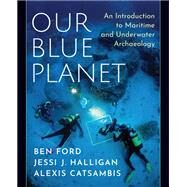Our Blue Planet: An Introduction to Maritime and Underwater Archaeology
, by Ford, Ben; Halligan, Jessi J.; Catsambis, Alexis- ISBN: 9780190649937 | 0190649933
- Cover: Paperback
- Copyright: 5/14/2020
Our Blue Planet provides a comprehensive introduction to the field of maritime and underwater archaeology. Situating the field within the broader study of history and archaeology, this book advocates that an understanding of how our ancestors interacted with rivers, lakes, and oceans is integral to comprehending the human past. Our Blue Planet covers the full breadth of maritime and underwater archaeology, including formerly terrestrial sites drowned by rising sea levels, coastal sites, and a wide variety of wreck sites ranging across the globe and spanning from antiquity to World War II.
Beginning with a definition of the field and several chapters dedicated to the methods of finding, recording, and interpreting submerged sites, Our Blue Planet provides an entry point for all readers, whether or not they are familiar with maritime and underwater archaeology or archaeology in general. The book then shifts to a thematic approach with chapters exploring human interactions with the watery world, both along the coasts and by ship. These chapters discuss the relationships between culture, technology, and environment that allowed humans through time to spread across the globe. Because ships were the primary means for humans to interact with large bodies of water, they are the focus of several chapters on the development of shipbuilding technology, the lives of sailors, and the uses of ships in exploration, expansion, and warfare. The book ends with chapters on how and why the non-renewable submerged archaeological record should be managed, so that both current and future generations can learn from the achievements and failures of past societies, as well as on how anyone can become involved in maritime and underwater archaeology. Throughout, the reader benefits from the personal reflections of a number of leading figures in the field.
Beginning with a definition of the field and several chapters dedicated to the methods of finding, recording, and interpreting submerged sites, Our Blue Planet provides an entry point for all readers, whether or not they are familiar with maritime and underwater archaeology or archaeology in general. The book then shifts to a thematic approach with chapters exploring human interactions with the watery world, both along the coasts and by ship. These chapters discuss the relationships between culture, technology, and environment that allowed humans through time to spread across the globe. Because ships were the primary means for humans to interact with large bodies of water, they are the focus of several chapters on the development of shipbuilding technology, the lives of sailors, and the uses of ships in exploration, expansion, and warfare. The book ends with chapters on how and why the non-renewable submerged archaeological record should be managed, so that both current and future generations can learn from the achievements and failures of past societies, as well as on how anyone can become involved in maritime and underwater archaeology. Throughout, the reader benefits from the personal reflections of a number of leading figures in the field.







